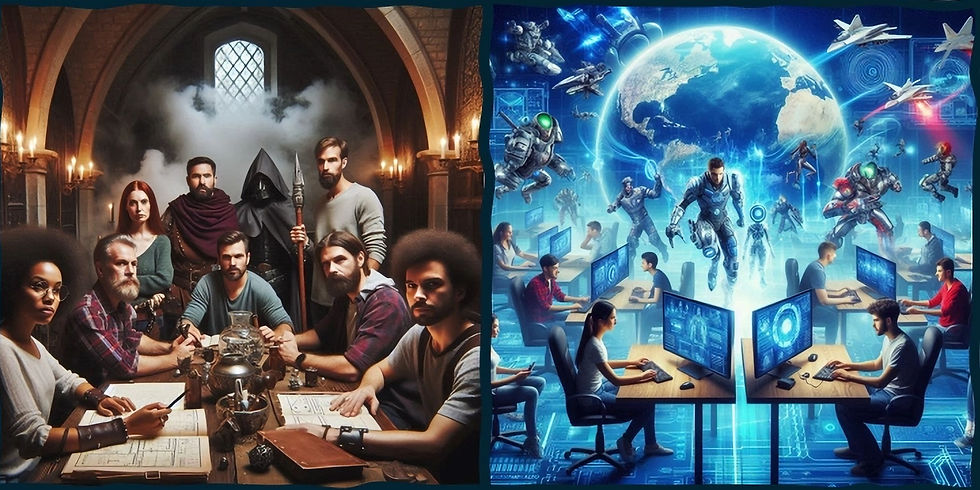Exploring TTRPGs Online: A Guide for GMs
- Lorelis Eathalen

- Sep 18, 2024
- 3 min read

As a Game Master (GM), the way you facilitate your tabletop roleplaying games (TTRPGs) can significantly impact the experience for your players. While traditional in-person sessions have long been the norm, the rise of online platforms has opened up new possibilities for gameplay. Understanding the pros and cons of online play compared to in-person sessions can help you adapt your style and provide an engaging experience for your players.
The Advantages of Online TTRPG Play
One of the most significant benefits of online TTRPGs is accessibility. With virtual tabletop (VTT) software, you can connect with players from different locations, making it easier to include friends who live far away or have irregular schedules. This flexibility allows you to form diverse groups that might not be possible in a traditional setting. Online play also offers enhanced visual aids. VTTs provide tools for creating detailed maps, character tokens, and automated combat systems that streamline gameplay. These features can enhance immersion and help keep track of complex encounters, allowing you to focus more on storytelling and less on logistics. Additionally, online platforms often come with built-in resources like rule compendiums, character sheets, and dice rollers. This can reduce prep time and ensure that everyone has access to the same materials, leveling the playing field for new and experienced players alike.
The Drawbacks of Online Play
However, online play is not without its challenges. One of the primary downsides is the potential loss of social interaction. In-person sessions foster camaraderie through shared experiences—laughing together, sharing snacks, and reading body language can create a unique atmosphere that’s hard to replicate online. The lack of physical presence may lead to distractions from other online activities, making it difficult for players to remain engaged. Technical issues are another concern. Connection problems, audio glitches, and software crashes can disrupt the flow of the game. As a GM, you'll need to be prepared to troubleshoot these issues or adapt your session if they arise.
Finding a Balance
Many GMs find success by adopting a hybrid approach—combining in-person play when possible with online tools when necessary. This allows you to enjoy the benefits of both formats while mitigating some of their drawbacks. Ultimately, whether you choose to run your games in person or online depends on your group’s preferences and circumstances. By understanding the strengths and limitations of each format, you can create engaging experiences that cater to your players’ needs. Embrace the flexibility that online TTRPGs offer while maintaining the core elements that make tabletop gaming so enjoyable: storytelling, creativity, and connection.
What other GMs have to say in the matter
The DM Liar focuses on Improving online play with a DM screen, VTT, push-to-talk audio, initiative tracking, shared music, digital handouts, virtual dice, video, backgrounds, snack breaks, whiteboards, and a Discord server.
Pointy Hat advocates for online play, highlighting benefits like global group access, no commute, and comfort. It encourages embracing online features such as evolving maps and audio effects while suggesting rituals to enhance emotional connections and immersion in gameplay.
Crucibles to try out in your next session
Experiment with virtual tabletops (VTTs): Set up a simple encounter using a VTT platform like Roll20 or Foundry. Focus on learning the tools for map creation, tokens, and automated combat. Pay attention to how these features streamline gameplay and improve immersion in an online setting.
Invite players from different locations: Organize an online game with players who live in different cities or have irregular schedules. Take note of how the accessibility of online play helps form a more diverse group and allows for consistent sessions.
Leverage online resources: Use built-in VTT resources like rulebooks, character sheets, and dice rollers. Run a session with minimal prep to see how these features reduce setup time and ensure that everyone has access to the same materials, leveling the playing field for your group.
Balance online and in-person interaction: Run a hybrid session where you combine in-person play with online tools (like virtual maps or digital character sheets). Assess how this mix enhances the experience for players by merging the strengths of both formats.
By practicing these exercises, GMs can better adapt to the online TTRPG format, ensuring a smooth and immersive experience for their players.



Comments